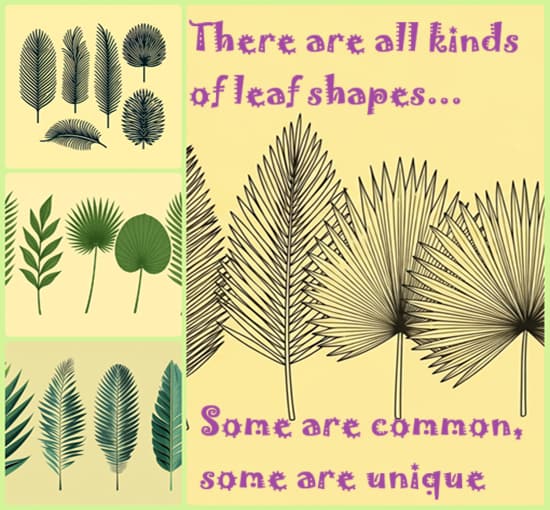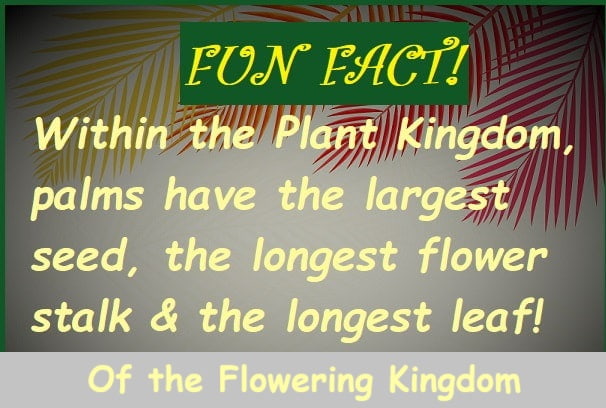- Home
- What are Palms?
- Palm characteristics
Characteristics of a Palm Tree
Anatomy Structures With Fun Facts!
The characteristics of a palm tree is what makes each one unique.
How are they different from other trees? Or other plants?
The answer is found in the special palm traits. From different leaves to record-setting seeds and flowers. This guide explains palm tree anatomy in simple terms, with fun facts you can share.
What Makes Palm Trees Unique?
The short answer is that palms are not “typical trees.”
They are monocots, which means their structure is totally different.
Palms may look like ordinary trees, or even bushes. But because they are monocots, they have more in common with grass. Does that seem strange?
Feeling overwhelmed by so many palm trees?
You're not alone. We Understand your headaches! At Mission: Palm Trees you'll find clear answers to questions & Step-By-Step Guidance, from real people. With solutions to help. No puzzling shoptalk. No tiring research. So it's easy & fun for you.
So Then - Are Palm Trees Really Trees?
Palm trees are not true woody trees. Instead, they are Monocot Plants with a single growing point at the top. Their trunks do not form growth rings like oak or maple trees.
So we see, palms may look like ordinary trees, but they are actually very different. Because of the characteristics palms have as monocots, it means they grow more like grass than like any oak or pine tree.
Palm tree trunks, roots, and leaves don’t behave the same way as “regular” trees.
The Main Characteristics of Palm Trees
Let's see more about the characteristics of palms, by looking at the Different Palm Tree Parts.
Palm Trees Are Monocots
BECAUSE A PALM IS A MONOCOT...
A monocot is a type of plant that shows special features such as:
- Their flowers have three parts - or multiples of three. For example, six, nine or twelve.
- It sprouts with one single leaf, after beginning germination. It's called a cotyledon.
- Its Method For Getting Nutrients from the ground is totally different. With fronds having parallel veins. Not at all like the other plant forms, called Dicots.
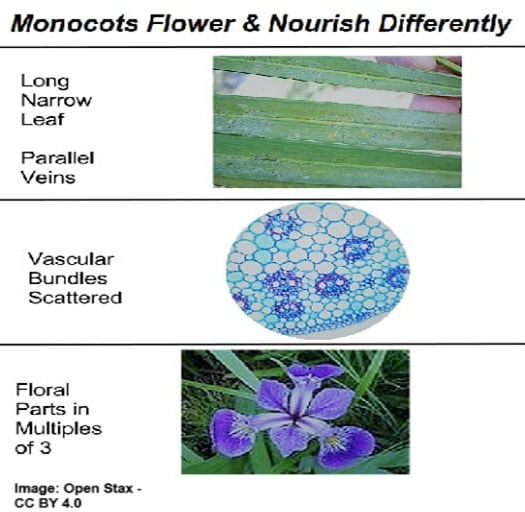
Palm Leaves Have a Unique Design
Palm leaves, called fronds, as the main characteristics of a palm tree. Most come in two main shapes, each with those parallel veins:
- Pinnate (feather-shaped) – long and narrow like a feather.
- Palmate (fan-shaped) – wide and rounded like a fan.
Palm Roots Work Differently
Among the most important palm tree characteristics is their root system.
As with monocots, a palm begins forming roots at the bottom of its stem, or trunk. This is the specialized root production area called the "Root Initiation Zone." They're fibrous, spreading out widely, not far under the ground's surface. Becoming a dense mat-like structure, which helps them anchor into sandy or rocky soils.
They're adventitious roots which means they begin forming from non-root tissue - the baby palm's stem. They grow out at their maximum thickness, and don't have root hairs. Unlike other trees, they don’t send down a deep taproot with branching roots in decreasing size.
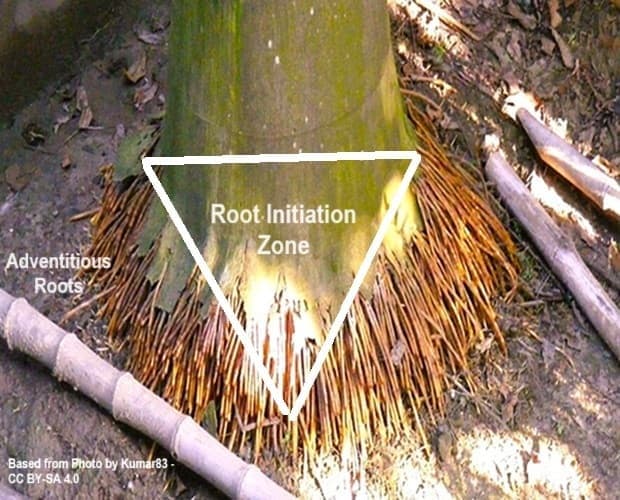 Note how the roots are all the same thickness!
Note how the roots are all the same thickness!Palm Trunks Come in Many Forms
Palm trunks add to the variety of palm tree hallmarks.
Palm trunks can be solitary, clustering, vining, or underground.
People typically think of palm trees as having that straight tall trunk. Those are the ones with a solitary trunk.
These are topped by a mass of palm fronds circling the crown.
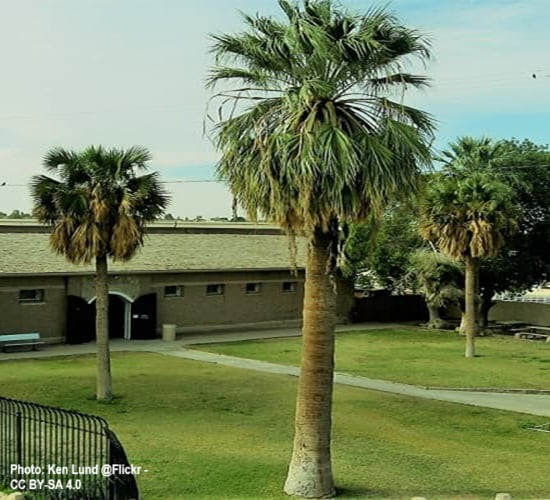 Palms With Solitary Trunks
Palms With Solitary TrunksClustering Palm Trunks
Palm trees can grow in a shrub-like manner. They could be used to form a hedge.
Instead of one trunk (stem), they grow many trunks, all adjacent to each other. But that's a clustering or clumping style of growth.
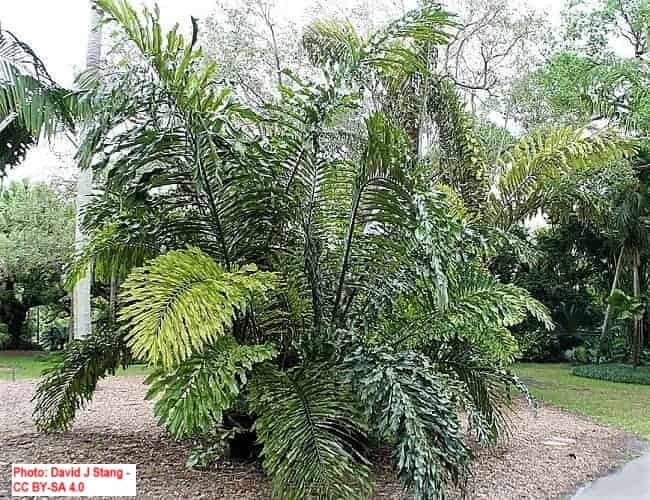 Arenga undulatifolia, called the Sugar Palm.
Arenga undulatifolia, called the Sugar Palm.It has multiple trunks, which aren't branches.
But Watch Out! Its nasty fruit irritates skin.
Climbing Vine Palms
To the surprise of many, some palms are vine-like.
They've developed methods to use nearby plants to help them climb upwards in a forest or jungle canopy.
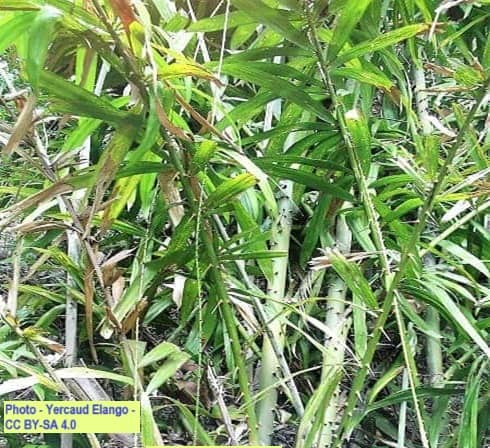 Calamus rotang is a Climbing Rattan Palm
Calamus rotang is a Climbing Rattan PalmPalms With No Trunk!
Some palms appear to have no trunk at all!
Their fronds seem to sprout right up from the ground. But it's not really that there's no trunk. These types of palm trunks are subterranean. They grow beneath the ground!
Others trick you into believing they have no trunk. But their trunks aren't obvious because they spread out along top of the soil! And are typically hidden beneath their fronds or other plants.
Butea microspadix Has an Underground Trunk
Fun Facts About Palm Trees
Some palm tree characteristics are record-breaking. Because they're the palm ultimates - by having the:
- Longest leaf in the flowering plant kingdom.
- Largest seed (the coco de mer).
- Longest flower stalk.
Palm Flowers and Fruit
The flowers and fruit you see on palms are not often very exciting! See why.
Do Palm Trees Make Flowers?
Palm flowers bloom in multiples of three, just like other monocots. With 3, 5, 9, 12, etc. petals.
Most are usually small, cream-colored, and grouped together. Individually they're not remarkable looking. But they might stand out because their many flowers bloom clustered - packed together along the flower stem.
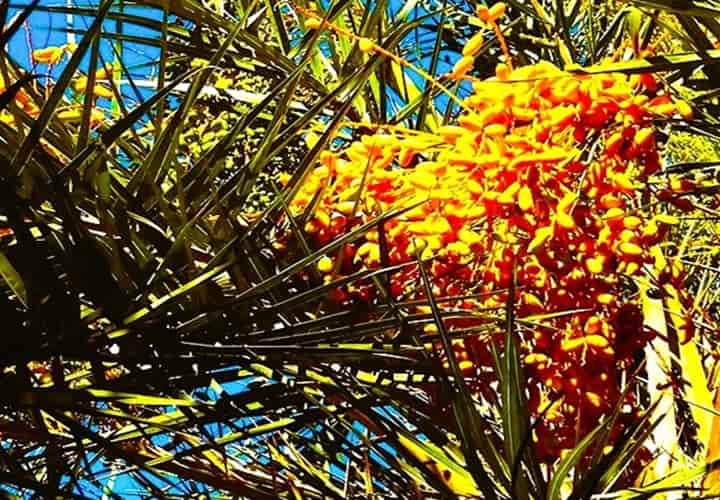 Phoenix sylvestris flowers stashed together thickly, with triple-styled petals.
Phoenix sylvestris flowers stashed together thickly, with triple-styled petals.Famous Fruit-Bearing Palms
Many palm fruits are slightly larger than a marble. Their colors are usually black, blue.
Some palm species have fruits that really stand out. The most renowned palms for their fruits are the coconut, date, acai, oil palm.
Coconut palms of course Produce Coconuts. Cocos nucifera is very useful for food. But it's also made into oil for beauty products, etc. There are even more Uses for the Coconut.
Date palms produce edible dates.
Phoenix dactylifera is a palm with important economic benefits, world-wide. Even where we live, in Arizona. We love getting a date shake or a package of dates in Dateland, Arizona!
 Dateland Arizona - a few hours drive from our home.
Dateland Arizona - a few hours drive from our home.Açaí palms produce berry-like fruits.
These açaí (pronounced: ah - sigh - ee) berries are sweet and yummy. Great for turning into a puree. People love making ice creamy treats and açaí bowls from them, and using them in tea.
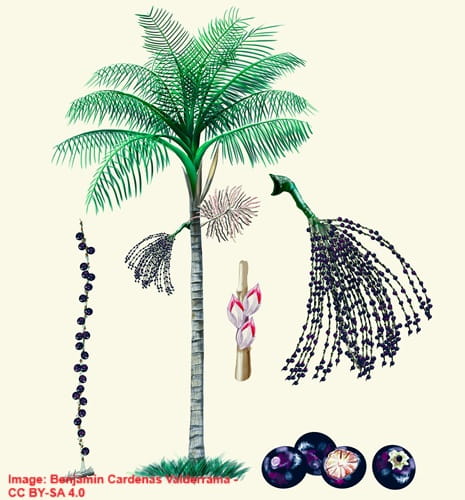
The African Oil Palm (Elaeis guineensis) is well-known for the commercial production of palm oil.
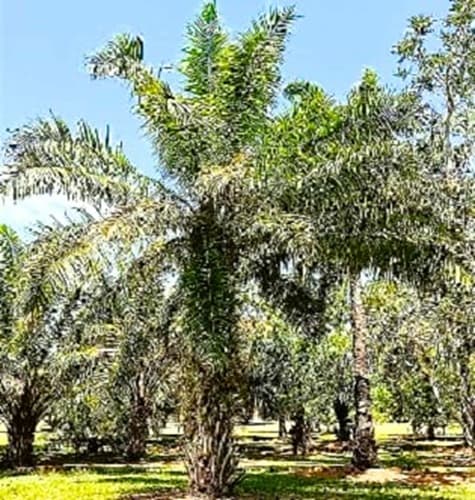 Elaeis guineensis, not yet fruiting.
Elaeis guineensis, not yet fruiting.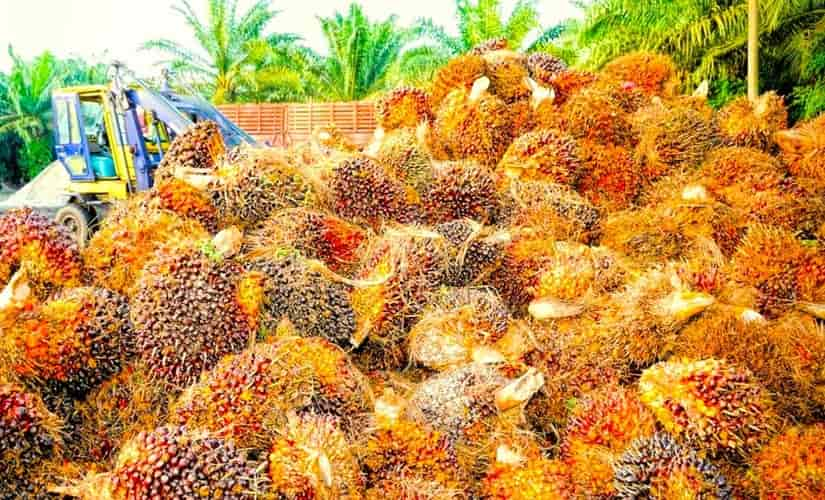 Elaeis guineensis fruits gathered in net-bags to be sent for oil production.
Elaeis guineensis fruits gathered in net-bags to be sent for oil production.How Palm Trees Grow and Live
You've been seeing how palms are very Different Types of Plants. Especially when compared to the trees you've always known.
Here are several more important things to know about How Palms Grow, and how long a lifespan they have.
Why Palm Trees Don’t Have Growth Rings
A unique palm tree characteristic is that their trunks don’t add new rings each year.
Instead, they grow to their full thickness early in life. Once they're done accomplishing that, they'll only then begin to get taller. So there's no new expansion of the trunk each year.
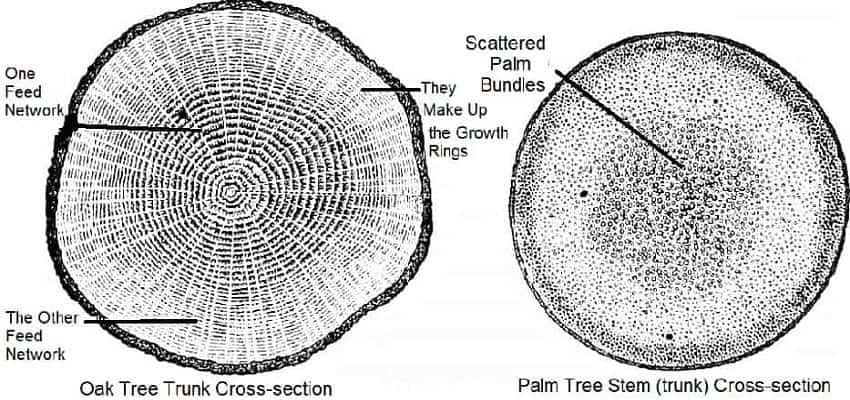 Cross-section of oak shows circular growth rings - nothing like that on a palm!
Cross-section of oak shows circular growth rings - nothing like that on a palm!How Long Do Palm Trees Live?
Palm lifespans vary widely.
- One palm, Corypha umbraculifera, The Talipot Palm lives for 30 to 80 years. It has a specifically measured time for life. As it flowers one time and then dies.
- Some palm species are short-lived, lasting only about 40 to 50 years. Like some species of the Pigafetta, Metroxylon and Caryota genera.
- While others, like Date Palms and Royal Palms, can survive for more than 200 years.
These life spans are part of their natural palm tree characteristics.
But other Problems for Palms can affect their lifespan. Disease, lightning strikes, and Inadequate Nutrition can end a palm's life earlier than expected.
One other factor is Where a Palm is Growing.
- Growing in their Native Habitat for the Palm helps them live out their full natural life.
- But when palms are domesticated for commercial distribution for Home Landscaping and business properties, their lifespan are often shorter. And their height is usually shorter, also.
So you see there isn't an exact answer.
Why Palm Trees Matter
Palms have their important place in the world. See the essential values of palms.
Palm Trees in Culture
They add to culture, being famed through history for their meaning. They add to economies throughout the world.Palms are ancient symbols of victory, peace, and paradise. They appear in art, flags, and traditions around the world.
See How They've Been Revered by Clicking Here>
Ecological Importance
In their natural environment, they contribute. An essential palm tree characteristic is their role in the ecosystem. Along coastlines, their roots help protect beaches from erosion.
- Palms provide food, oftentimes needed by cultures world-wide. Plus, and many other useful products.
- Palms provide homes for animals.
- Palms provide some shade, while Beautifying Landscapes. They filter air: producing oxygen while absorbing carbon dioxide.
- In beachside resorts they offer coastal protection because of the structure and growing pattern of their roots. Protecting beach sand from erosion.
Characteristics of a Palm Tree - FAQ
What is unique about the palm tree?
What is unique about the palm tree?
There are several unique characteristics of a palm tree.
- Their roots grow differently, spreading wide & shallow.
- The leaves have parallel veins.
- Parts of their flowers, like the petals always come in threes.
- Their trunks are very strong, and Don't Form Growth Rings.
What are the main characteristics of a palm tree?
What are the main characteristics of a palm tree?
Palm trees are monocot plants with unbranched trunks. Large fronds grow out from the top of the trunk. The leaves are feather-shaped (pinnate) or fan-shaped (palmate).
There's no bark or growth rings, they have fibrous roots, and produce fruits such as coconuts or dates. Most species grow best in tropical or subtropical climates.
How can you identify a palm tree?
How can you identify a palm tree?
The characteristics of a palm tree always helps to identify them.
Individual species could have smooth, ringed or fibrous trunk that has multiple forms. Typically, the trunk is topped by a crown of fan-like or feather-like fronds.
Palm tree trunks can be solitary, clustered, vining, or hidden underground, giving them very different appearances.
You can regularly See How to Identify a Palm Tree Here>
What type of leaves do palm trees have?
What type of leaves do palm trees have?
Palm trees have evergreen leaves usually Referred to as Fronds. They're almost always either pinnate, resembling feathers, or palmate, resembling fans.
- Fronds grow at the crown of the trunk, for that distinctive palm canopy.
- They have parallel veins instead of branching veins like most trees.
What kind of root system does a palm tree have?
What kind of root system does a palm tree have?
Palm trees have a fibrous root system. Thousands of roots grow from the base of the trunk, spreading outward anchoring it in the soil instead of growing deeply. Which helps them grip into sandy or rocky soils. Unlike many trees, they do not grow deep taproots.
Do palm trees have branches?
Do palm trees have branches?
No, nearly all palm trees do not have branches.
Palms Regularly Grow as a single stem with fronds at the top, which can appear like branches - but they're not. They're the leaf stem, called a petiole.
Some species do grow in clumps with multiple stems, but they're each a separate trunk. Palms do not form woody branches like other trees. Although there is a rare exception to that rule!
Quick Recap: the Characteristics of a Palm Tree
Oh those characteristics of a palm tree! Understanding palm tree characteristics helps you see palms in a whole new way. Remember these?
- Palms are monocots, and not true trees.
- Their roots spread widely, but not deep.
- Leaves are often called fronds. They're parallel-veined and shaped like fans or feathers.
- Trunks can be solitary, clustered, vining, or underground.
- Palms hold records for the largest seed, longest leaf, and longest flower stem.
The next time you see a palm, you’ll know it's more than just a tropical symbol. The unusual characteristics of palm trees are as fascinating as their record-breaking seeds and fronds. Palm trees may look simple, but their structure tells a bigger story.
Please keep exploring here, and discover more surprising facts about palms. Whether you love palms for their beauty, their history, or their fun facts, there is always more to learn!
